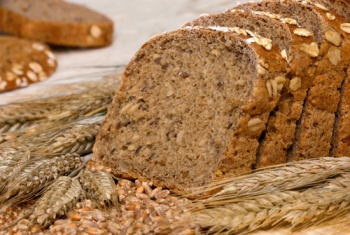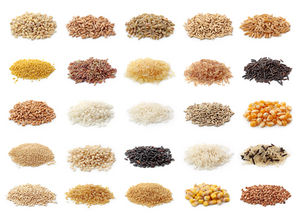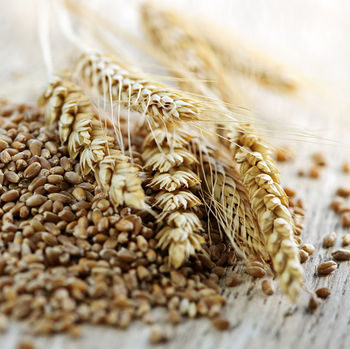Grains
| See Also | Clinical Nutrition |
|---|
Grains are the seeds of various grasses such as wheat, oats, barley, rice and rye, and are often referred to as cereal grains. Grains are considered to be the most important food crop in the world, and in many countries are the primary form of sustenance.[1]
Contents
Classification
- The kernel (seed) of a grain consists of three parts: the bran, the endosperm and the germ.
- The bran is the protective outer layer of the grain and provides the majority of the dietary fiber and the largest share of nutrients. It supplies 86% of the niacin or Vitamin B3, 43% of riboflavine or Vitamin B2 and 66% of all the minerals.
- The endosperm is the largest part of the whole grain and accounts for 83% of the grain’s weight and most of protein and carbohydrates. It also provides a small amount of vitamins and minerals.
- The germ is the smallest part of the grain constituting only 2% of the kernel’s weight. It contains a fair amount of polyunsaturated fat and consequently is removed during the milling process to prevent grain products from turning rancid. The germ provides the largest amount of B vitamins, vitamin E, minerals and essential fatty acids in the grain.[2], [3]
Grains are classified into two different groups based on their composition: whole grains and refined grains.[4]
- Whole grains contain all three parts of the kernel, whereas refined grains have had some or all of the bran and germ removed and only consist of the endosperm. As such, whole grains are much higher in fiber and contain more vitamins, antioxidants, minerals and phytonutrients than those that are refined.
- Refined grains refer to grain products and grain flours that have been significantly altered from their natural state. They are often called milled grains because both the bran and the germ are removed from the grain kernel during the grinding or sifting process.
Whole Grains
Whole grains can be eaten either on their own or as an ingredient in more complex products. Some common whole grains include:[1] [4], [3], [5], [6]
- Amaranth is a gluten-free grain that is high in protein, calcium, folacin, and magnesium. This grain has a high iron content and provides more than 4 times the amount of iron in brown rice.
- Barley grows well in a variety of climates and as such has become a major food staple in many parts of the world. Most of the barley grown in North America is converted into malt for beer production or used as animal feed. This grain is milled to remove most of the bran and the most common forms include: flakes, grits, hulled, pearl, and Scotch (pot) barley. As with oats, barley is a great source of soluble fiber.
- Buckwheat Despite its name, buckwheat isn’t actually related to wheat, but rather to a leafy plant belonging to the same family as rhubarb and sorrel. Buckwheat lacks the bran and germ but still has a moderate fiber content and is also high in the essential amino acid lysine. It has a strong, nutlike flavour that is quite distinctive, and is often used in pancakes and Soba noodles.
- Maize (Corn) Contrary to popular perception, corn is a grain. The corn plant is a grass and the kernels are the grain. Corn is an important crop in North America there are two main types: Field corn is the non-sweet variety that is picked when it’s very mature and used in a multitude of ways: as livestock feed, in a variety of processed foods and drinks (e.g.: whiskey, cornstarch, corn syrup) as a fuel source and in paper and plastics. Sweet corn is a good source of vitamin C and A (in the form of beta carotene) and is primarily eaten raw or cooked as a summer vegetable.
- Oats are a popular grain in North America and primarily consumed in cold cereals, muffins, cookies, cakes, breads and as hot oatmeal. Oats are a great source of complex carbohydrates and contain 50% more protein than bulgar wheat and twice as much as brown rice. Oats also provide a good source of folacin, zinc, manganese, copper and vitamin E. Over the past few decades there has been an increased interest in the health benefits of oats. Since 1963 more than 20 clinical studies have shown that oats are effective in lowering high cholesterol levels. The consumption of 3 grams of soluble oat fiber (one bowl of oatmeal) by individuals with high cholesterol levels (above 220 mg/dl) was shown to lower total cholesterol by 8 to 23%.
- Rice (Brown) is the most important grain in Eastern Asia where 94% of the world’s rice supply is grown. It is estimated that half the global population eats rice as their staple food. Rice is a good source of iron, phosphorus, magnesium and B vitamins such as thiamin (B1) and niacin (B3). Rice is classified according to size: long-grain, medium-grain and short-grain. Long-grain rice accounts for approximately 75% of the total rice grown and consumed. Brown rice provides significantly higher nutritional benefits than white rice which has been completely milled to remove the husk, bran and majority of the germ.
- Rye is a very hard, bitter grain commonly used in sourdough breads and crackers. When eaten in its raw, sprouted state or as soaked flakes, rye is a rich source of fluorine which helps to strengthen tooth enamel.
- Quinoa has the highest protein content of all the grains, more calcium than milk, and is a very good source of iron, phosphorus, B vitamins and Vitamin E. Quinoa is a good grain for vegetarians, vegans and people who are gluten-intolerant.
- Wheat is considered to be the most important cereal crop in the world. The majority of wheat is milled into flour – usually white. There are six classes of wheat each of which differ with respect to their planting season, outer texture and strength, and kernel colour. These include: hard red winter, soft red winter, hard red spring, hard white, soft white, durum
- The hard wheats have a higher protein-to-starch ratio than the soft wheats. Durum is the hardest of all the wheats and is processed into semolina and used to make pasta. Hard red winter, hard red spring and hard white wheats are all milled into bread flour and all-purpose flour. Soft red winter and soft white wheats are milled into flour used in cakes, pastries, cookies and crackers.
Refined Grains
- Refined grains refer to grain products and grain flours that have been significantly altered from their natural state. They are often called milled grains because both the bran and the germ are removed from the grain kernel during the grinding or sifting process. These grains are then further refined during the process of mixing, brominating and bleaching which makes them easier to chew, quicker to cook and less likely to spoil in warm environments. What remains is a nutrient deficient but calorie-dense starchy white inner core, which is ground into different sizes for different purposes.
- Commonly produced refined-grain products include: white rice, white flour, white bread, whole wheat flour, pasta (non-wholewheat varieties)
Nutritional Value
Grains are among the best sources of carbohydrates, as 65-90% of the calories in a grain are derived from complex carbs.
The nutrition contained in grains depends entirely on the form in which you eat them. As a result of the removal of the majority of essential nutrients in refined grains in the milling process whole grains are nutritionally superior.
Following is a summary of the nutritional value of each of the grain components (in grams)
| Carbs | Protein | Fats | Fiber | Iron % daily | Other | |
| Bran | 63 | 16 | 3 | 43 | 59 | B vitamins |
| Endosperm | 79 | 7 | 0 | 4 | 7 | |
| Germ | 52 | 23 | 10 | 14 | 35 | B vitamins, Omega 3 &6 |
Whole Grains:
- While whole grains such as brown rice and barley are a good and inexpensive source of low-fat protein, in most cases the protein is deficient in lysine, (an essential amino acid), and are therefore incomplete.
- Quinoa is the only whole grain that contains all the essential amino acids and is considered a complete protein. In fact, just one cup of cooked quinoa contains 18 grams of protein and nine grams of fiber. [3]
| Grain | Fiber Content (g) |
| Oatmeal, 1 cup | 3.98 |
| Whole wheat bread, 1 slice | 2 |
| Whole wheat spaghetti, 1 cup | 6.3 |
| Brown rice, 1 cup | 3.5 |
| Barley, 1 cup | 13.6 |
| Buckwheat, 1 cup | 4.54 |
| Rye, 1/3 cup | 8.22 |
Refined Grains Following are the average levels of nutrients missing in refined grains:
- 19% of the protein has been removed.
- 66% of the B vitamins have been removed.
- 70% of all minerals have been removed.
- 79% of the fiber has been removed.
Enriched Grains
- In an effort to increase the nutrient value of refined grains manufacturers often enrich them with vitamins and minerals such as niacin, riboflavin and iron that were lost during processing, storage or transport.
- However, the nutrients added back in are often synthetic replacements and not at the same levels as the whole grain, and therefore don't have the same health promoting properties. A common example of an enriched grain is white flour.[6], [2]
Benefits
Diets rich in whole grains have been shown to protect against the development of chronic degenerative diseases including: cancer, diabetes, and stroke.
- Consumption of whole grains has been consistently linked with a significant decrease in risk factors for cardiovascular disease. Regular whole-grain consumption lowers LDL and triglyceride levels, which in turn contributes to an overall 26% reduction in coronary heart disease-risk factors.[7]
- Whole-grain consumption is inversely related to the risk of hypertension, diabetes, and obesity when compared to refined grains, all of which are negative indicators in total cardiovascular health.[7]
- Consumption of whole grains is associated with decreased risk for type 2 diabetes as they lower fasting insulin concentrations and improve insulin sensitivity when compared to those associated with the consumption of refined grains. This effect was far more pronounced amongst obese and hyperinsulinemic subjects.[8]
- Wheat bran is used to treat constipation as it is an effective bulk laxative due to its high fiber content. On average, 1/3 of a cup is often sufficient to stimulate the bowels and promote movement of their contents.
- As a result of their high nutrient and fiber content whole grains are also associated with a lower risk of inflammatory bowel disease, diverticulitis, varicose veins and hemorrhoids.[4]
Specific Consideration
Shopping
- If you buy grains in bulk it’s best to purchase them from a store that has high turnover to ensure freshness and a decreased risk of mold.
- Grains should be clean and dry, free from debris and fresh-smelling.
- For optimal nutritional benefits, buy breads and cereals made from whole grains. The first ingredient listed should be whole wheat, whole oats, whole rye, whole grain corn, brown rice, wild rice, barley, bulgur, or oats.
- Products labeled as 100% whole wheat or 60% whole wheat are not actually whole grain products. If whole wheat flour is a whole grain, you will see the words “100% whole-grain whole wheat” or “whole wheat flour with added germ.”
- In Canada, it is legal to advertise any food product as "whole wheat" with up to 70% of the germ removed.[2]
- It is best to look carefully at the ingredient list rather than the colour of a food to select whole grain foods. For example, brown bread may simply be white bread coloured with molasses.[9]
- Contrary to popular belief, fiber is not indicative of whole grains. The amount of fiber varies from grain to grain, and some products may contain ingredients like bran, peas, or other foods added to boost the fiber content.[10]
Storage
- Despite their fairly long shelf life relative to produce such as fruits and vegetables, whole grains are susceptible to mold and insects and can turn rancid due to their natural oil content. It is best to keep grains in a tightly closed container and store them in a dark, dry place for no longer than one month.
- If you keep whole grains in the refrigerator in a moisture- proof container they can last up to four to five months. If you freeze grains they can keep almost indefinitely. The exception to this is oats and oat bran which are higher in fat and therefore turn rancid in two to three months time even when frozen.[3]
Glycemic Index
- Any product made with flour has the potential to affect blood sugar whether the flour is produced from whole grains or refined. The act of grinding grains into flour increases the surface area upon which enzymes work, which in turn accelerates the conversion of starch into glucose.
- Grain products which haven’t been milled or processed can slow or prevent the digestion of starch. The retarding of starch digestion can help decrease or prevent spikes in blood sugar.[11]
Gluten Intolerance
Wheat, rye, oats and barley are all grains that contain gluten. Gluten is made up of two proteins: gliadin and glutenin each which work to give flour its elasticity and strength, and allow it to rise when baked. Some people have an allergy to gluten or are not able to digest this protein as in the case of Celiac disease.
- Quinoa, brown rice, millet, teff amaranth, and buckwheat are good gluten-free whole grain alternatives.
Allergies
Wheat is one of top five most common food allergens. Allergy sufferers should avoid all foods and products that contain wheat products and learn to identify other names for wheat. Following are the most common sources of wheat and alternative names for this grain:
- Couscous
- Durum
- Einkorn
- Emmer
- Enriched, white and whole-wheat flour
- Farina
- Fu
- Graham, high-gluten and high-protein flour
- Kamut
- Seitan
- Semolina
- Spelt (dinkel, farro)
- Triticale (a cross between wheat and rye)
- Triticum aestivum
- Wheat bran, flour, germ
References
- ↑ 1.0 1.1 Murray Michael T (1993) The Healing Power of Foods Prima Publishing.
- ↑ 2.0 2.1 2.2 2.3 Eat Right Ontario Choosing Whole Grains FAQs http://www.eatrightontario.ca/en/Articles/Food-guides/Choosing-Whole-Grains-FAQs Retrieved 1 March 2012.
- ↑ 3.0 3.1 3.2 3.3 3.4 3.5 Margen S (1992) The Wellness Encyclopedia of Food and Nutrition Random House.
- ↑ 4.0 4.1 4.2 Kirschmann and Kirschmann G (1996) Nutrition Almanac Fourth Edition McGraw-Hill.
- ↑ Pitchford Paul (2002) Healing with Whole Foods: Asian Traditions and Modern Nutrition Third Edition North Atlantic Books.
- ↑ 6.0 6.1 Balch Phyllis (2006) A Prescription for Nutritional Healing Fourth Edition New York: Avery.
- ↑ 7.0 7.1 Whole Grain Foods and Heart Disease Risk Journal of American College of Nutrition http://www.jacn.org/cgi/reprint/19/suppl_3/291S. Retrieved 3 March 2012.
- ↑ Wholegrain intake is favorably associated with metabolic risk factors for type 2 diabetes and cardiovascular disease in the Framingham Offspring Study Journal of American College of Nutrition http://www.ajcn.org/cgi/reprint/76/2/390. Retrieved 3 March 2012.
- ↑ Health Canada: Canada’s Food Guide, Tips for Grain Products http://www.hc-sc.gc.ca/fn-an/food-guide-aliment/choose-choix/grain-cereal/tips-trucs-eng.php Retrieved 3 March 2012.
- ↑ Whole Grains Council - Identifying Whole Grain Products". http://www.wholegrainscouncil.org/whole-grains-101/identifying-whole-grain-products. Retrieved 3 March 2012.
- ↑ "Glycemic Index – From Research to Nutrition Recommendations?" (PDF) http://www.norden.org/pub/velfaerd/livsmedel/uk/TN2005589.pdf. Retrieved 3 March 2012.


